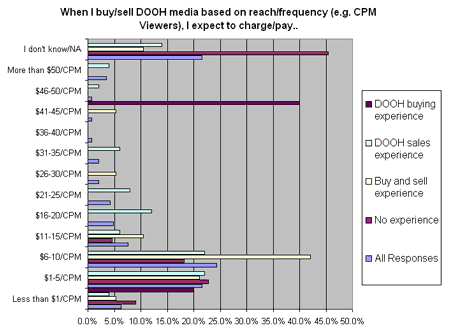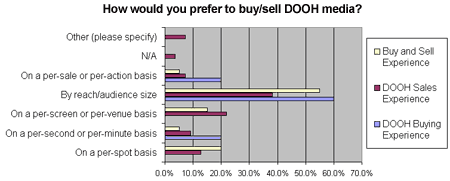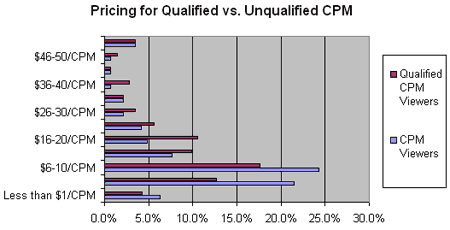Mean versus median pricing
In the previous article, we mentioned that the average (mean) sale price for DOOH media is about $12 on a CPM Viewers basis, with most people indicating a price in the $1-$10/CPM range. We noted, though, that there were a few people who entered very high CPM prices ($50 or more), which partly muddied the picture. Consequently, recalculating for the median instead of the mean, we learned that the median CPM Viewers price, which is probably a little more representative of what's being bought/sold in the real world, is more like $6.50.
I wanted to take this a step further and see how the price estimates differed between those who had buy-side experience and those who had sell-side experience, as well as those who had experience with both roles and those who didn't have experience with either of them. However, as you can see from the graph below, the results were quite uniform. In other words, regardless of experience level, most people implicitly "felt" that DOOH ads are worth somewhere in the $1-10 range, again with a median of around $6.50.

Note the big spike up in the $41-$45/CPM range from those with buy-side experience only. At first glance, that might seem to indicate that media buyers/planners are actually prepared to pay a lot more for DOOH than the data otherwise suggests. However, we only had a very small group (less than 10) of these folks actually complete the questionnaire, compared to 175+ total respondents, so their contribution doesn't meaningfully skew the numbers. And since those who had both buy and sell-side experience voted a lot more like everyone else, my only guess is that the handful of media buyers who took the survey and answered this question had some specific high-dollar-value campaigns and placements in mind. I don't want to devalue those answers -- there may well be a different pricing perception at the big media buying/planning agencies -- we just don't have enough data from these people to say that for sure.
Buying on reach versus buying on action
Another thing I found quite surprising was how people would prefer to buy or sell DOOH media. As we talked about last week, buying based on a reach number like CPM Viewers is currently the most popular method, probably because advertisers are used to this metric when purchasing other kinds of media. However, few seemed to be interested in a cost-per-action model that would charge based on how many viewers actually acted upon an ad (presumably by interacting with the sign, taking a coupon, making a purchase or doing some other measurable task):

Not surprisingly, DOOH sellers (who probably consist mainly of network owners) are least enthusiastic about this option, since it means more work and more risk for them -- especially since much of the sales impact comes from content these people will frequently have little control over. Buyers showed a little more interest, but still only 20% of these folks said that pay-per-action would be their preferred buying method. So I think the voice of the industry speaks loud and clear here: buyers and sellers currently rely on CPM Viewers to get DOOH deals done, and that doesn't look like it will change in the immediate future.
How much are better metrics worth?
Everyone likes talking about metrics, and how great it will be when we can scan a shopper's head in real-time as they walk into the store, pull up every last detail about them, and then beam an appropriate message directly into their brain. But how much of that is just lip service? We asked people to indicate how much they would pay for a "qualified" reach measurement like eyes-on, versus the standard CPM Viewers measurement priced out above. The answer turns out to be: "a decent amount," as you can see from the chart below:

In short, screens boasting a qualified reach measurement like eyes-on can command an impressive-sounding 32% price premium. However, this only comes out to about $4 per thousand viewers since the mean cost for qualified CPM Viewers was about $16 (though the median price was also around $16, suggesting there may be more demand for measured spots). Thus, I would say at this point that qualified reach measurement may make your DOOH network more valuable, but depending on your audience size, the cost of implementing the additional metrics may not be worthwhile.
If you're like me, the numbers above raise just about as many questions as they answer. We still have a lot more analysis coming up, including a look at the differences between the various pricing mechanisms surveyed and an examination of per-screen and per-spot pricing trends. For now, though, I'd love to hear your thoughts on the above.
Do these results surprise you? Are they higher, lower, or about even with your own expectations and experiences? Leave a comment and let us know. (If you're viewing this in your email or RSS reader, click through to /blog to comment.)

 Subscribe to the Digital Signage Insider RSS feed
Subscribe to the Digital Signage Insider RSS feed
Comments
Thank you!
This data is the result of an in-house survey conducted on about 300 end-users and integrators in 2011.
RSS feed for comments to this post